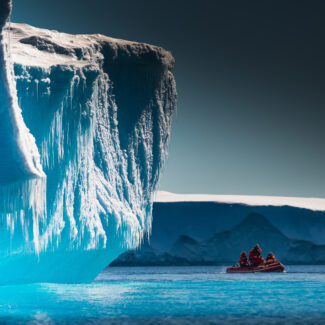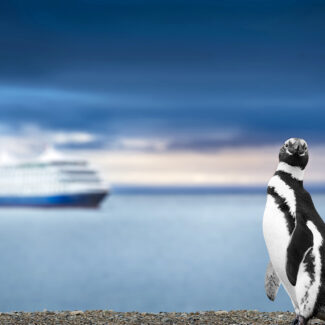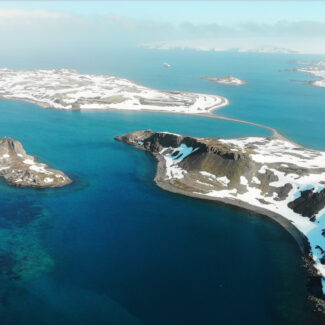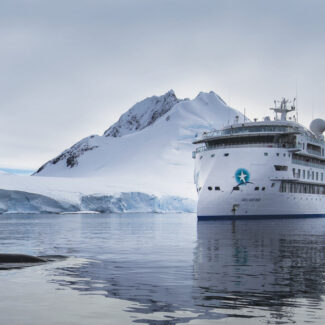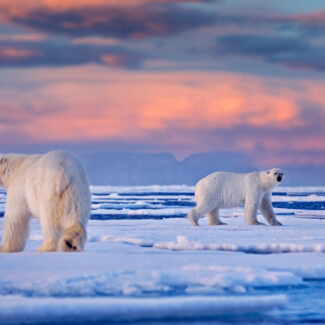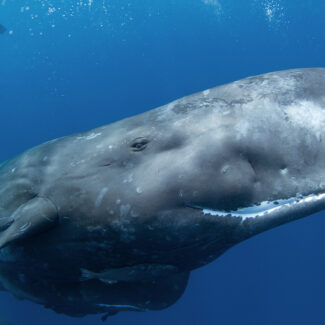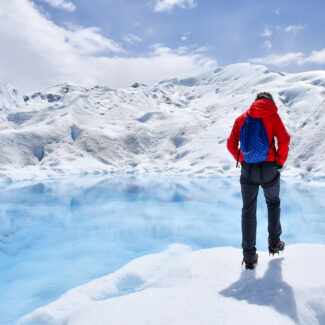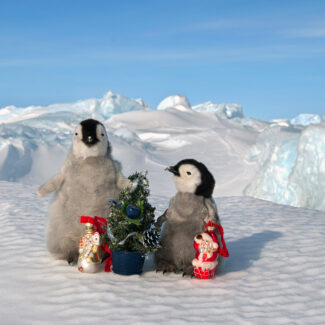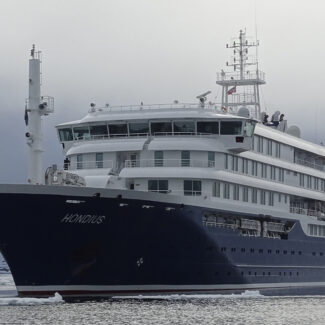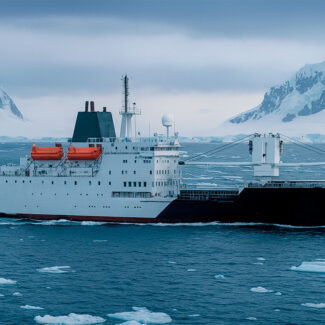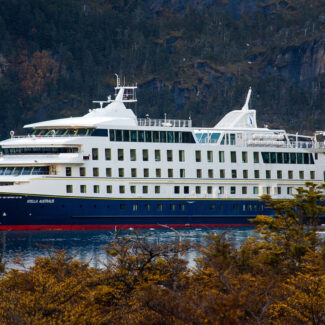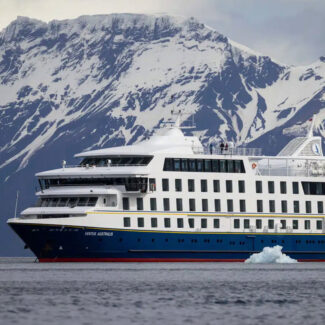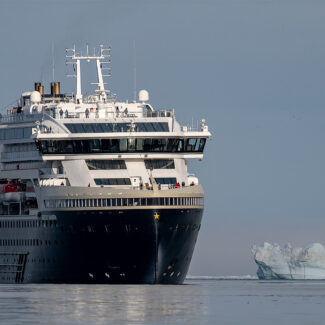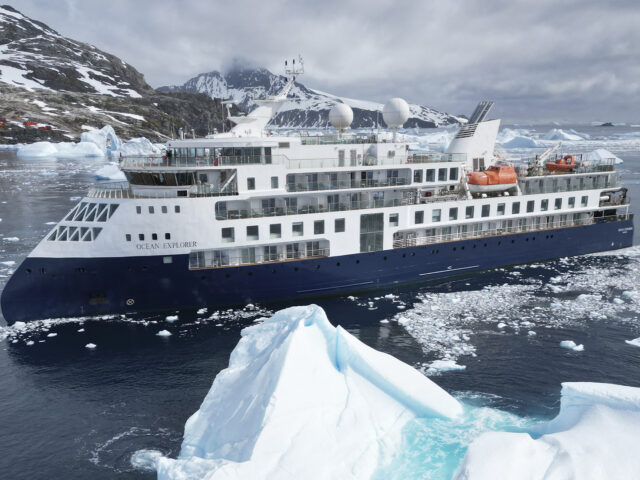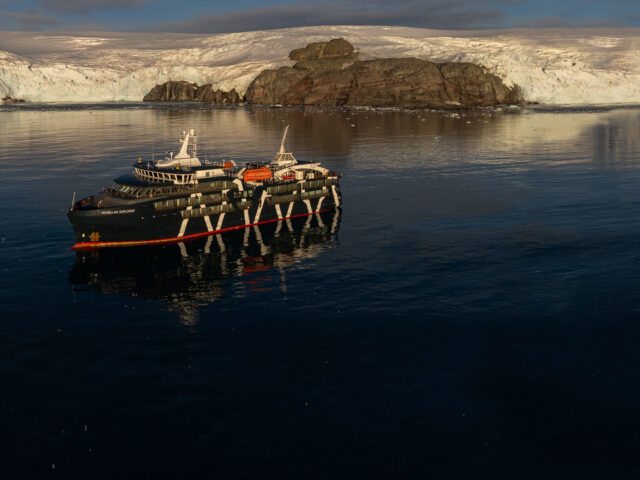National Geographic Endurance
Highlights
- X-Bow® design ensures smoother sailing in rough polar seas, increased fuel efficiency, and stunning forward-facing views from multiple decks.
- Complete with two infinity-style hot tubs, sauna with a view, and a glass-walled yoga studio for serenity amid the sublime.
- Home to National Geographic photographers, naturalists, and scientists who enrich your journey with stories, expertise, and hands-on learning.
The National Geographic Endurance is a pioneering vessel redefining expedition cruising at the poles. Built in 2020 and accommodating just 138 guests, she combines polar-class strength with sleek Scandinavian-inspired design. Her distinctive X-Bow® hull design makes for quieter, more efficient crossings and unmatched stability—even in notoriously rough seas. Life on board is both elegant and deeply immersive, with spacious suites and cabins—many with private balconies—and open, convivial shared spaces crafted to bring guests together after days of bold exploration.
The ship’s interiors are thoughtfully appointed in natural materials and neutral tones, creating a warm and sophisticated ambience where adventure and comfort co-exist. The dining experience is a highlight in itself, with gourmet meals served in the main restaurant and a bistro-style eatery offering lighter fare. Lounges with panoramic views, a state-of-the-art science hub, and cozy nooks like the library or the sauna overlooking the polar wilderness offer plenty of choice for how you wind down between adventures. Meanwhile, the expert staff—including National Geographic photographers, expedition leaders, and naturalists—ensure each journey is not only awe-inspiring but intellectually enriching.
Polar Adventures
National Geographic Endurance offers a curated range of itineraries in both the Arctic and Antarctica. In Antarctica, she journeys deep into the White Continent, the W...
Specifications
-
Guests126
-
Staff & Crew116
-
Guide & Crew to Guest Ratios1:8 / 1:1.2
-
Guest to Space Ratio1:93
-
Number of Decks6
-
Number of Cabins76
-
Zodiacs & Loading Bays14
-
Year Built2020
-
Ice ClassPC5
-
Length408.0 ft (124.0 m)
-
Beam69.0 ft (21.0 m)
-
Draft18.7 ft (5.7 m)
-
Cruising Speed17 Knots
-
StabilizersYes
Amenities
About the National Geographic Endurance
The National Geographic Endurance is a pioneering vessel redefining expedition cruising at the poles. Built in 2020 and accommodating just 138 guests, she combines polar-class strength with sleek Scandinavian-inspired design. Her distinctive X-Bow® hull design makes for quieter, more efficient crossings and unmatched stability—even in notoriously rough seas. Life on board is both elegant and deeply immersive, with spacious suites and cabins—many with private balconies—and open, convivial shared spaces crafted to bring guests together after days of bold exploration.
The ship’s interiors are thoughtfully appointed in natural materials and neutral tones, creating a warm and sophisticated ambience where adventure and comfort co-exist. The dining experience is a highlight in itself, with gourmet meals served in the main restaurant and a bistro-style eatery offering lighter fare. Lounges with panoramic views, a state-of-the-art science hub, and cozy nooks like the library or the sauna overlooking the polar wilderness offer plenty of choice for how you wind down between adventures. Meanwhile, the expert staff—including National Geographic photographers, expedition leaders, and naturalists—ensure each journey is not only awe-inspiring but intellectually enriching.
Polar Adventures
National Geographic Endurance offers a curated range of itineraries in both the Arctic and Antarctica. In Antarctica, she journeys deep into the White Continent, the Weddell Sea, and even ventures to South Georgia and the Falklands—lands of massive penguin colonies, seal-strewn beaches, and rich Shackleton history. In the Arctic, she navigates the ice-choked waters of Svalbard, Greenland, and Iceland, with itineraries designed around seasonal wildlife events, including polar bear sightings and bird migrations.
Daily excursions get guests off the ship and into the wild—whether by Zodiac cruise among blue-tinged icebergs, hiking across tundra, snowshoeing into the silence of polar valleys, or kayaking along sculpted coastlines. Optional activities include undersea exploration, polar plunges, and photography workshops. Every landing brings new possibilities, from standing before vast glaciers to spotting whales beneath midnight sun skies.
Sustainability & Innovation
Sustainability is core to Endurance’s mission. She is fully equipped with Tier 3 engines that significantly reduce emissions, and her advanced hull design minimizes fuel consumption. The ship features dynamic positioning to avoid anchor damage to fragile seabeds, and plastic use is actively reduced on board.
With her ice-strengthened hull, she can access remote regions that are unreachable by traditional cruise ships, bringing guests closer to untouched nature while treading lightly. Guests are invited to take part in Citizen Science programs, from cloud observations to plankton sampling, contributing to real-world research during their voyage.
Embark on a polar odyssey aboard National Geographic Endurance walking in the footsteps of legendary explorers, witness nature at its most raw and radiant, and forge bonds with people driven by a shared thirst for knowledge and discovery. Whether you’re a seasoned adventurer, a passionate photographer, or simply a dreamer ready to go where few ever have, this journey is for you. Expect to return home changed—not only by the places you’ve been, but by the deeper connection you’ve made with our planet and its fragile beauty.
Cat 3 - Main Deck
Features
Description
Cat 2 - Fore Deck
Features
Description
Cat 4 - Lounge Deck
Features
Description
Cat 6 - Bridge Deck
Features
Description
Cat Solo A - Main Deck
Features
Description
Cat Solo B - Lounge Deck
Features
Description
Cat 1 - Fore Deck
Features
Description
Cat 5 - Bridge Deck
Features
Description
Cat 7 - Bridge Deck
Features
Description
Itineraries
Acclaimed documentary photographer Chris Rainier specializes in highlighting endangered cultures and traditional languages around the globe. In 2002, he received the Lowell Thomas Award from The Explorers Club for his efforts in cultural preservation and was elected in 2014 as a Fellow of the Royal Geographical Society of London, where he specializes in cultural preservation. During his continued tenure with the National Geographic Society as a National Geographic Fellow and Explorer, he has been the co-founder and co-director of the Enduring Voices Project and director of the All-Roads Photography Program, both designed to support indigenous groups desiring to document their traditional cultures and create sustainable solutions to preserve the planet in the 21st century.
Rainier also served as a cultural editor and photographer for National Geographic Traveler magazine for over 18 years. Today he directs The Cultural Sanctuaries Foundation, whose mission is to create legally protected cultural zones around the globe that protect both traditional knowledge as well as the biodiversity the communities are guardians of. In the early 1980s, Chris served as the last assistant for famed photographer Ansel Adams. The two worked together to amplify the use of art photography as a social tool, ultimately helping to preserve threatened wilderness areas and national parks in the United States.
Rainier has traveled extensively across the globe, from South America to the South Pacific, Antarctica and the Russian Arctic, and beyond. He was one of the first journalists to journey to the Russian North Pole aboard a Russian icebreaker when the Soviet Union ended. Since then, Chris has travelled extensively on National Geographic Expeditions on the Lindblad ships as well on the Jet Expeditions. Chris has a deep passion for teaching photography, particularly for the National Geographic Expeditions for the past 20 years.
Award-winning photographer and filmmaker Rich Reid has specialized in environmental and adventure photography for over three decades. On assignment with National Geographic Adventure, he cycled Alaska’s Inside Passage by ferry and explored California’s Gaviota Coast by bike and kayak. North American Nature Photography Association elected Rich as a Fellow for his significant contributions to nature photography, and he was a finalist for the BBC Wildlife Photographer of the Year for his time-lapse video documenting forest fire ecology.
His start in photography was accepting the full-time positions as photo editor for the college yearbook and daily newspaper while pursuing his business economics degree from the University of California, Santa Barbara. This is where his love of the natural world and art merged to create a lifelong passion for the environment. His work to advocate the preservation of the Gaviota Coast in Southern California was highlighted in National Geographic magazine titled ‘New Park for California Coast?’ Alaska captured Rich’s imagination early in his life as a camping guide leading guests throughout the state photographing wildlife and landscapes from the temperate rain forest to the arctic tundra. He has shared his photography passion as an Alaskan tour operator, Visual Journalism instructor at Brooks Institute in California, and now as a National Geographic photographer with Lindblad Expeditions.
Rich has served on photo expeditions to Antarctica, South Georgia, the Falklands, Svalbard, Galapagos, British Columbia, and the Columbia and Snake Rivers. When not aboard, Rich is using his multimedia skills to preserve open spaces with non-profit organizations and teaching students the fundamentals of garden-based learning. He is based in Ojai, California.



